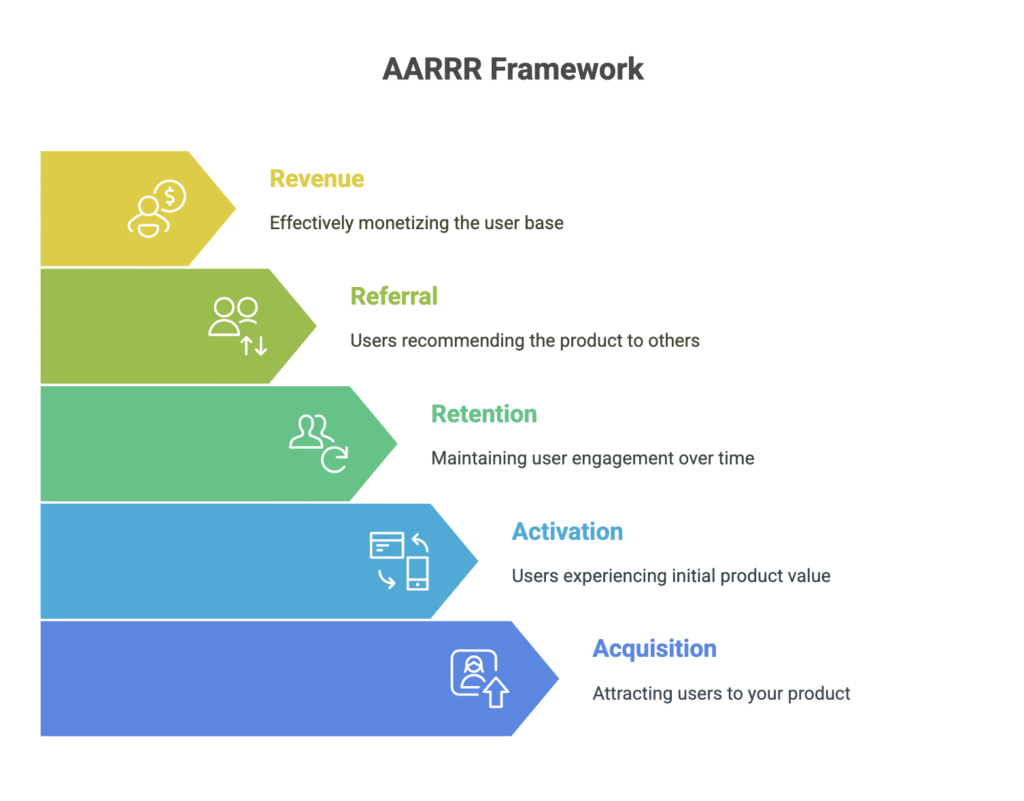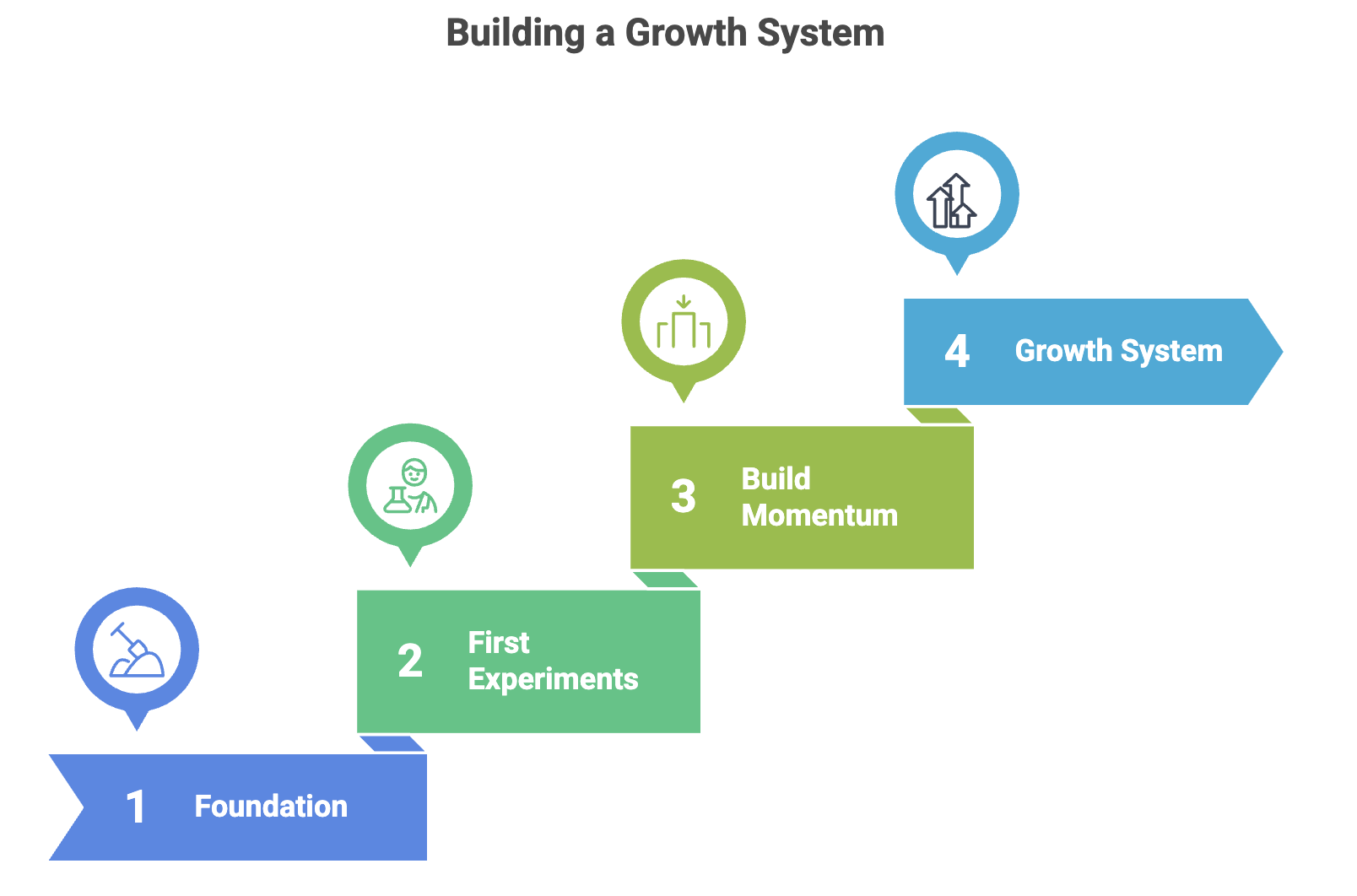Growth marketing: It seems self-explanatory. Isn’t the very purpose of marketing to grow your business? You track metrics like website visitors, leads, and customers looking for improvement.
But “growth marketing” actually refers to a very specific approach. It’s about businesses growing exponentially by discovering the power of combining creativity with data-driven practices – using both sides of the brain to create tailored marketing strategies.
So what exactly is growth marketing? How can businesses use it to their advantage? Is it right for your company? Read on to find out.
What is Growth Marketing?
Growth marketing is a systematic approach to finding scalable ways to grow your business. Unlike traditional marketing that relies on intuition and broad campaigns, growth marketing uses continuous experimentation, data analysis, and rapid iteration to discover what actually drives sustainable growth.
Growth marketers don’t just launch campaigns and hope for the best. They build hypothesis-driven experiments, measure everything, and constantly optimize based on real results. It’s where marketing meets scientific method.
How is Growth Marketing Different from Traditional Marketing?
Growth marketing is anything but old school. Here’s how it differs:
Traditional Marketing:
- Campaign-based with set timelines
- Relies on established best practices
- Measures success at the end of campaigns
- Focuses primarily on acquisition
- Uses broad targeting and messaging
Growth Marketing:
- Continuous experimentation and optimization
- Data-driven decision making at every step
- Real-time measurement and adjustment
- Optimizes the entire customer lifecycle
- Highly targeted and personalized approaches
Think of it like this: Traditional marketing is like following a recipe, while growth marketing is like being a chef who tastes and adjusts at every step, constantly experimenting with new ingredients to create the perfect dish.
Key Aspects of Growth Marketing
Data-Driven Decision Making
Every decision is backed by data, not hunches. Growth marketers track granular metrics, analyze user behavior, and make decisions based on statistical significance rather than opinions.
Experimentation and Testing
Growth marketers embrace a culture of continuous testing. They use A/B testing, multivariate testing, and other methodologies to constantly refine their approach. No assumption goes untested.
Customer-Centricity
The focus shifts from pushing products to understanding customer needs and optimizing their entire journey from awareness to advocacy.
Agile and Iterative Approach
Growth marketing operates in rapid cycles – hypothesis, test, analyze, implement, repeat. This allows for quick adaptation to changing market conditions.
Full-Funnel Optimization
Rather than focusing solely on top-of-funnel acquisition, growth marketing optimizes every stage of the customer journey for maximum impact.
The AARRR Framework: Your Growth Foundation
Growth marketing is structured around the AARRR framework (also called Pirate Metrics):
- Acquisition: How users discover your product
- Activation: When users experience initial value
- Retention: Keeping users engaged over time
- Referral: Users bringing new users through recommendations
- Revenue: Monetizing the user base effectively

Each stage requires different tactics and metrics, but they all work together to create sustainable growth loops.
What is Required for Growth Marketing Success
So what do you need to succeed with growth marketing? Here’s what you’ll need:
- The ability to test everything: Views, clicks, visits, time spent, customer lifetime value – if it can be measured, it should be measured.
- Robust data infrastructure: You need tools that can track user behavior, run experiments, and provide actionable insights in real-time.
- Cross-functional team: Growth marketing requires creatives, analysts, engineers, and strategists working closely together.
- Experimental mindset: Willingness to try new approaches, fail fast, and iterate based on learnings.
- Long-term commitment: Growth marketing isn’t about quick fixes – it’s about building systems that compound over time.
Building Your Growth Team
Essential Roles
- Growth Strategist: Develops hypotheses and manages the experiment pipeline
- Data Analyst: Interprets results and identifies opportunities
- Growth Engineer: Implements tests and builds measurement infrastructure
- Creative Lead: Develops messaging and assets for testing
- Product Marketer: Ensures growth initiatives align with product strategy
Team Structure
Growth teams work best as small, autonomous units that can move quickly. Typically 3-7 people who can take an idea from hypothesis to implementation without external dependencies.
Growth Marketing Metrics That Matter
Choose metrics that directly correlate with business growth. Here are the key ones to track:
- Customer Acquisition Cost (CAC): Average cost to acquire a new customer
- Customer Lifetime Value (CLV): Total revenue a customer generates over their lifetime
- Conversion Rate: Percentage of visitors who take desired actions
- Retention Rate: Percentage of customers who continue using your product
- Viral Coefficient: How many new users each existing user brings
- Time to Value: How quickly new users experience product benefit
- Monthly Recurring Revenue (MRR): Predictable monthly revenue from subscriptions
The key is choosing one “North Star Metric” that best represents value delivery to customers and correlates with business success.
Growth Marketing Channels and Tactics
Paid Acquisition
- Search advertising: Target high-intent keywords with optimized landing pages
- Social media ads: Leverage platform targeting for precise audience reach
- Programmatic display: Retarget and expand audiences based on behavior
Organic Growth
- Content marketing: Create valuable content that attracts and educates prospects
- SEO: Optimize for search visibility on relevant topics
- Social media: Build communities and engage audiences authentically
Product-Led Growth
- Onboarding optimization: Reduce time to value for new users
- In-product messaging: Guide users to discover key features
- Viral mechanics: Build sharing and referral directly into the product
Retention and Expansion
- Email automation: Nurture users with behavioral triggers
- Push notifications: Re-engage inactive users
- Upselling sequences: Introduce premium features to engaged users
How to Implement Growth Marketing: Step-by-Step
Step 1: Audit Your Current State
Before optimizing, understand where you stand:
- Map your current customer journey
- Identify conversion bottlenecks
- Audit your data tracking capabilities
- Assess your team’s skills and capacity
Step 2: Choose Your North Star Metric
Select the one metric that best represents customer value and business growth. This becomes your team’s primary focus and decision-making filter.
Step 3: Set Up Measurement Infrastructure
Implement robust analytics that can track:
- User behavior across all touchpoints
- Conversion events and micro-conversions
- Cohort performance over time
- Experiment results with statistical significance
Step 4: Start Small with High-Impact Tests
Begin with experiments that are:
- Easy to implement quickly
- Have high potential impact
- Can be measured reliably
- Build team confidence and capability
Step 5: Build Your Experiment Pipeline
Create a systematic approach to running tests:
- Generate hypotheses based on data insights
- Prioritize experiments using frameworks like ICE scoring
- Run tests with proper statistical rigor
- Document learnings for future reference
Step 6: Scale What Works
Once you identify winning tactics:
- Expand successful experiments across channels
- Hire additional team members to manage growth
- Invest more budget in proven channels
- Build systems to automate successful processes
Common Growth Marketing Mistakes to Avoid
- Focusing Only on Acquisition: Don’t neglect retention and expansion. It’s often easier and more profitable to grow existing customers than acquire new ones.
- Testing Without Statistical Rigor: Running tests that are too short, too small, or without proper controls leads to false conclusions and wasted resources.
- Chasing Vanity Metrics: Focus on metrics that directly correlate with business outcomes, not just impressive-looking numbers.
- Moving Too Fast: Give experiments enough time to reach statistical significance. Premature optimization can lead to poor decisions.
- Neglecting the Long Term: Balance quick wins with sustainable growth strategies that build lasting competitive advantages.
Growth Marketing Tools and Technology
Analytics Platforms
- Google Analytics 4: Website behavior and conversion tracking
- Amplitude: Product analytics and user journey analysis
- Mixpanel: Event tracking and funnel optimization
Experimentation Tools
- Optimizely: A/B testing platform for websites and mobile apps
- VWO: Conversion optimization and testing suite
Customer Data Platforms
- Segment: Unified customer data collection and routing
- mParticle: Customer data infrastructure for growth teams
Marketing Automation
- HubSpot: Inbound marketing and sales automation
- Klaviyo: Email and SMS marketing with behavioral triggers
- Intercom: Customer messaging and engagement platform
The Future of Growth Marketing
AI and Machine Learning
Artificial intelligence is transforming growth marketing through:
- Predictive analytics: Forecasting customer behavior and lifetime value
- Automated optimization: AI-driven bid management and creative testing
- Personalization at scale: Dynamic content and individualized experiences
Privacy-First Strategies
With increasing privacy regulations:
- First-party data: Building direct relationships for data collection
- Contextual targeting: Advertising based on content rather than tracking
- Consent-based marketing: Creating value propositions for data sharing
Emerging Channels
New platforms create fresh opportunities:
- Voice search optimization: Adapting for voice-activated devices
- Conversational marketing: Chatbots and messaging platforms
- Community-driven growth: Building engaged user communities
Is Growth Marketing Right for Your Business?
Growth marketing works best when you have:
- Sufficient traffic/users: You need enough volume to run statistically significant tests
- Digital touchpoints: Most tactics require digital channels and measurement
- Growth potential: Your market and business model can support rapid scaling
- Team buy-in: Leadership and team commitment to data-driven experimentation
- Technical capability: Ability to implement tracking and run experiments
When to Wait
- You haven’t achieved product-market fit yet
- Your team lacks basic analytics capabilities
- You can’t handle rapid growth operationally
- Your business model has fundamental issues
Getting Started Today: Your Action Plan
Week 1: FoundConclusion: Transform Your Marketing Approachation
- Audit your current analytics setup
- Define your North Star Metric
- Map your customer journey and identify bottlenecks
- Assess your team’s growth marketing capabilities
Month 1: First Experiments
- Set up proper event tracking
- Design and launch your first A/B test
- Establish weekly review meetings for experiments
- Create a simple system for documenting learnings
Quarter 1: Build Momentum
- Hire or train team members in growth marketing skills
- Implement advanced analytics and attribution modeling
- Develop a systematic approach to experiment prioritization
- Scale your first successful experiments
Year 1: Growth System
- Build sophisticated growth loops and viral mechanics
- Implement predictive analytics and automation
- Create cross-functional growth processes
- Develop sustainable competitive advantages through systematic optimization
Transform Your Marketing Approach
Growth marketing isn’t just another marketing tactic – it’s a fundamental shift in how businesses approach customer acquisition, retention, and expansion. By combining creativity with rigorous data analysis, companies can build sustainable growth engines that compound over time.
The key is starting small, learning fast, and scaling what works. Whether you’re a startup looking to find product-market fit or an established company seeking to accelerate growth, the principles and frameworks outlined in this guide provide a roadmap for success.
Remember: growth marketing is a marathon run in sprints. Each experiment builds on the last, creating a knowledge base that becomes your competitive advantage. The businesses that embrace this approach today will be the ones dominating their markets tomorrow.
Ready to transform your marketing approach? Start with your North Star Metric, run your first experiment, and begin building the growth engine that will power your business’s future success.
